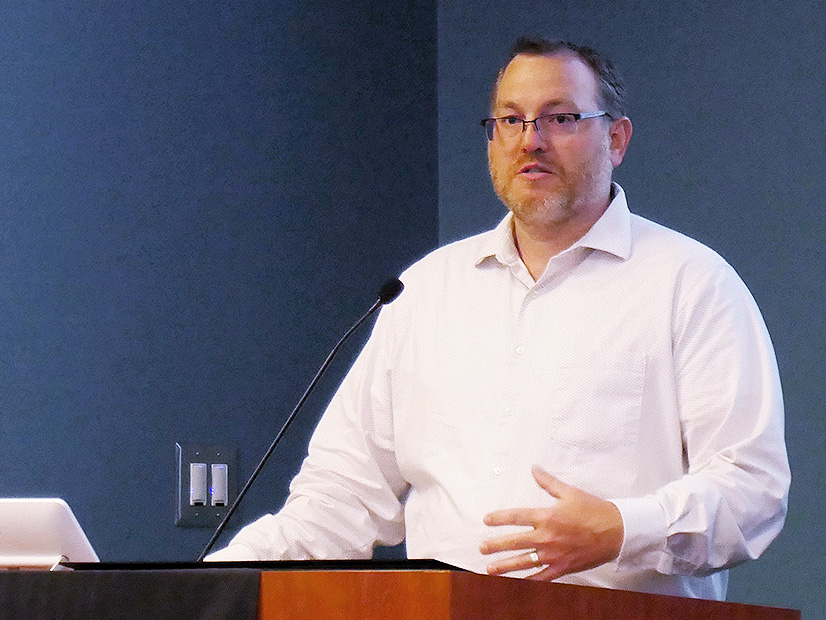CARMEL, Ind. — Faced with an exponential rise in interconnection requests, MISO last week announced that it is aiming to make its queue a more exclusive club through new rules.
The grid operator said it needs stricter requirements for developers to enter and exit the generator interconnection queue so it can make its studies more manageable.
“We need to govern the rules for exit and entry. We believe that will improve our queue,” MISO’s Andy Witmeier said at the Planning Advisory Committee’s meeting Wednesday. He said that if MISO imposes more requirements on land ownership, restricts the conditions for penalty-free withdrawals and increases some fees, it will shrink annual queue entrant classes.
Witmeier said 2022’s 171-GW queue class alone eclipses the typical systemwide 123-GW summer peak. MISO is bracing for another record-setting queue volume in 2023.
“It’s significantly more generation than would ever be built in MISO over the next few years, and there are concerns over how to study it,” Witmeier said. “More requests mean more points of interconnection and more study. There are more [hypothetical] overloads because of the sheer amount of capacity. That requires more engineering study.”
If MISO could cut down on the amount of “speculative requests,” it would result in study assumptions that better resemble the actual future dispatch, he said. “Smaller queue sizes mean faster results.”
Witmeier said it currently does not cost that much to enter MISO’s queue. And he said the RTO’s penalty-free withdrawal policy allows most interconnection customers who withdraw requests to get most of their money back. The $4,000/MW first milestone payment MISO requires of its projects is a “low bar” and represents only about 4% of the RTO’s approximate $100,000/MW financial feasibility threshold for the cost of network upgrades, he said. MISO’s deposits were last upped in 2018 and need to be increased, he said.
MISO will propose a package of alterations at the Planning Advisory Committee meeting in July, Witmeier said. After that, the RTO hopes to file a proposal with FERC in the third quarter and receive approval with enough time before year-end to close the 2023 queue application window. The RTO said it will keep the deadline open-ended until it receives FERC approval on the changes.
MISO was already planning to postpone the application deadline for its 2023 cycle of projects past its usual September cutoff. (See MISO: No Deadline Yet for 2023 Queue Applications.)
Witmeier said MISO is aware that enacting stricter requirements on queue entry can be perceived as it hindering generation development. But he said the real impediment to generation development is the flood of requests — with uncertain project plans among those — that bog down the study process and shift network upgrade costs to other projects. He added that only about 20% of the interconnection requests that enter the queue ever become realized generation projects.
Brattle Group Principal Johannes Pfeifenberger asked if MISO was worried that by restricting the entry of interconnection customers, it will raise the costs of network upgrades because there are fewer generation developers to split them.
Witmeier said he does not believe MISO will encounter that problem because it performs adequate backbone transmission planning through its long-range transmission plan (LRTP) portfolios. He said MISO avoids using its interconnection queue as a means to build major transmission. He also said the first, $10 billion LRTP portfolio likely drove up interconnection requests in 2022.
Witmeier said he plans to reach out to stakeholders to get their ideas on how to make queue entrances and exits less heavily trafficked.
The Sustainable FERC Project’s Natalie McIntire said she is concerned that MISO plans on privately discussing the changes with individual stakeholders.
“I think there needs to be a fairly lengthy stakeholder dialogue on this, and not behind closed doors,” McIntire said.
“We need to be able to work expediently on this. This is not a full-fledged redo of the queue,” Witmeier responded. “However, because we have so many requests, we have issues with speed and cost certainty. So, we have to adjust those rules.”
Witmeier said MISO’s penalty-free withdraw provision is akin to being able to play see the “river” card in Texas hold’em poker without matching a bet. “That’s just not right.”




